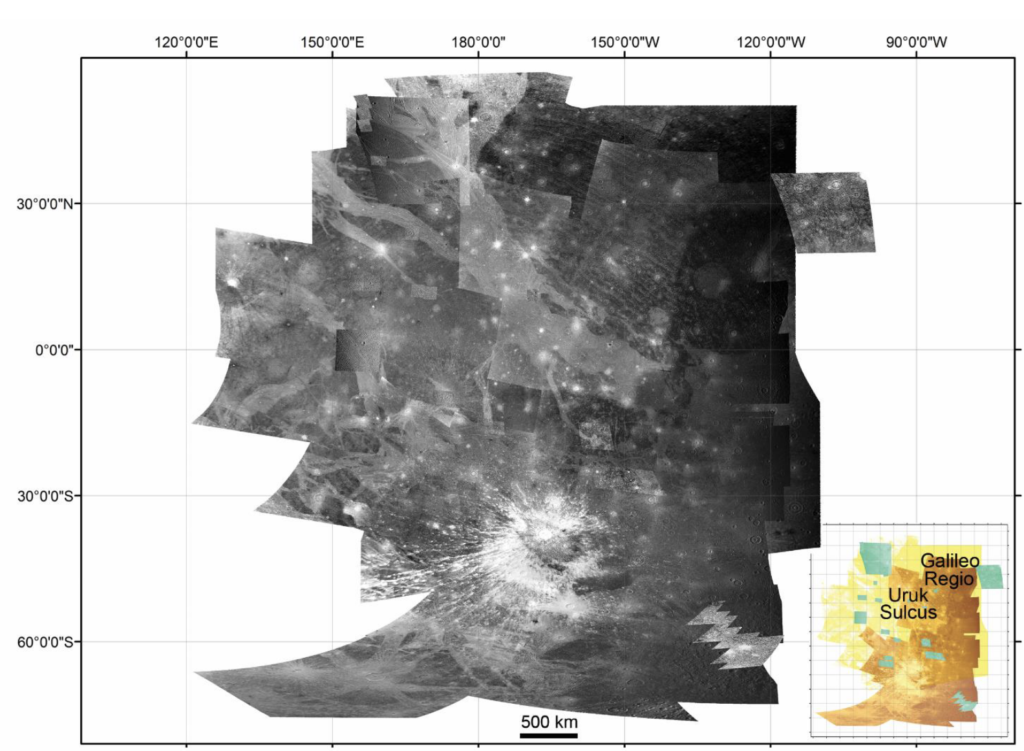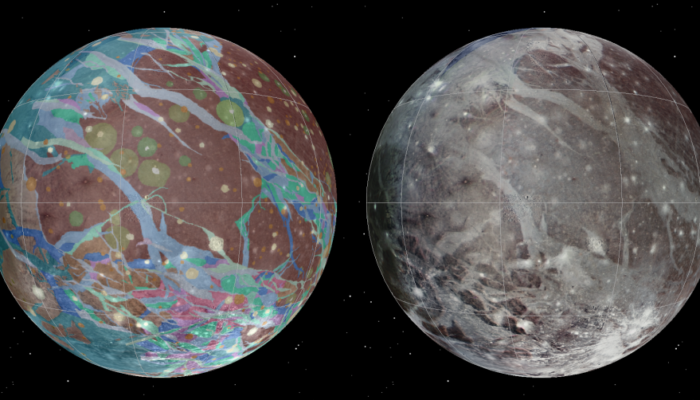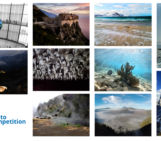In April this year a new mission is being launched by the European Space Agency, called JUICE, which stands for the Jupiter Icy Moons Explorer. This mission aims to make detailed observations of the giant gas planet Jupiter and its three large ocean-bearing moons – Ganymede, Callisto and Europa – with a suite of remote sensing, geophysical and in situ instruments.
But beyond the excitement of a new space mission and the interest that comes with learning more about one of the most iconic planets in our solar system, what in particular is so special about this mission?
In order to find out, we spoke with Dr Costanza Rossi from the Istituto Nazionale di Astrofisica, Padova, Italy, who’s work focuses specifically on one of Jupiter’s icy moons – Ganymede. “I began to study Ganymede during my Master degree and from that moment I never stopped!” she told us, “As a structural geologist, the deformed surface of Ganymede is very interesting and fascinating. There is the possibility to analyse a wide variety of tectonic structures, which often can be examples for textbooks. Moreover, rarely you can observe tangles of structure networks that crosscut the surface at global-scale as on Ganymede. Such structures represent pivotal evidence of past (and present?) geologic processes and play a key role for the connection with the subsurface ocean.”

This image shows what high resolution mosaics of the anti-Jovian hemisphere of Ganymede look like. Constructed from Voyager images with resolution ranging from 2468.06 to 1006.5 m/pixel and overlapping Galileo images (ranging from 291 meters/pixel to 41,73 m/pixel), more information is available in the full paper, available here (Rossi et al

An example of how Cosatnza produces the structural maps of her study area on Ganymede. This image is from her paper available here and shows structural mapping of the tectonic structures of Galileo Regio on the a) global mosaic of Ganymede (Kersten et al., 2021), showing b) a total of four structural systems: Lakhmu Fossae (red), Zu Fossae (orange), Lineated system (purple), and Precursor system (light-green).
In 2022 Costanza presented new research relating to tectonic phases in Galileo Regio, Ganymede’s dark terrain, at the EGU General Assembly in Vienna. In her presentation she explained new findings relating to Ganymede’s geological unit identified as the dark terrain, which is older and more densely cratered and furrowed than the younger, light terrain. The geology of Ganymede, like the other icy moons of Jupiter, is complicated by the moon’s subsurface ocean as Costanza describes, on top of which the brittle, tectonically active ice layer rests.
If you think studying the tectonics of an icy moon millions of mile away is a big challenge, you would be right! As Costanza explained, “Unfortunately, we have to deal with a remote body whose acquired image data are good, but their resolution leaves little room to the analysis, especially at local-scale. Ganymede’s tectonic processes are very puzzling and often it is needed to rack our brains to find the best method with limited data and understand what happened.”
Many of these challenges of understanding how the moon evolved geologically and how it will continue to develop are down to the images researchers currently have to work with. “The image processing is very challenging, too. We have several global-scale mosaics that are excellent and can be often the base of the work, but if it may occur to process the data on your own you will have to arm yourself of patience since a very meticulous, boring and long image processing awaits you.”
This is one reason that she is very much looking forward to the launch of the new JUICE mission, “This mission will have an enormous impact on my work! JUICE will acquire new and far better data of both surface and subsurface that will allow a better interpretation of the geologic features. I can’t wait to see such data, whose higher resolution will allow a better observation of the surface and will surely allow to understand more and more about Ganymede geology and tectonics.”
Costanza’s research will be used in the upcoming mission and will help prepare the observations that will be taken by the JANUS camera (which stands for Jovis, Amorum ac Natorum Undique Scrutator – Latin for ‘Jupiter, searching everywhere for his beloved and children’). The findings from this mission will help researchers across many different fields gain a better understanding of the Jovian system as a template to better understand gas giants throughout the universe, but also explore the possibility of these icy moons as a possible location for future human habitation!
Whatever happens we will be eagerly watching the data as it comes back, to learn more about these fascinating objects in space.
Further reading:
Rossi, C., Cianfarra, P., Salvini, F., Mitri, G. and Massé, M., (2018) Evidence of transpressional tectonics on the Uruk Sulcus region, Ganymede. Tectonophysics, 749, pp.72-87.
Rossi, C., Lucchetti, A., Massironi, M., Penasa, L., Pozzobon, R., Munaretto, G. and Pajola, M., (2023) Multi-phase activity on Ganymede’s dark terrain: Tectonic evolution of Galileo Regio. Icarus, 390, p.115305.





